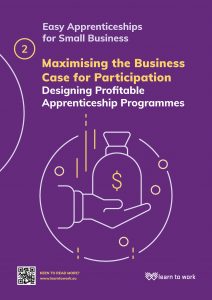Maximising the Business Case for Participation
Designing Profitable Apprenticeship Programmes
Easy Apprenticeships for Small Business
 The value proposition of an apprenticeship is straightforward: in return for providing students with much needed experience to the world of work, companies are offered subsidised labour of those same students. Thus, when properly managed, an apprenticeship programme turns a direct profit from the value of the work created by the apprentices.
The value proposition of an apprenticeship is straightforward: in return for providing students with much needed experience to the world of work, companies are offered subsidised labour of those same students. Thus, when properly managed, an apprenticeship programme turns a direct profit from the value of the work created by the apprentices.
Furthermore, apprenticeships create additional benefits for SMEs – such as improved staff retention levels, a better image in the sector and ultimately indirect profits from company’s stakeholders.
This booklet introduces you to the procedures which should be followed to ensure you’re your company achieves maximum return on its investment into apprenticeships, while at the same time ensuring that each student gains the experience they require for their training.
- Apprentices bring the latest “state of the art” into companies, in terms of the technical and scientific knowledge they have acquired during their education
- Students fresh in the working environment introduce ‘out of the box’ thinking and new perspectives to finding solutions to current challenges and issues.
- Apprenticeships can fill skills gaps in your organisation and lead to improved productivity and competitiveness.
- Taking on board an apprentice is a perfect opportunity to support your extension into new markets or development of new products
- The labour-costs of apprentices are highly-subsidised implying higher efficiency overall for their employers.
“Apprentices make great low-skill temporary workers”
All too often, companies deploy apprentices to take over low-skill temporary jobs, which their full-time staff would prefer not to deal with. While this approach may reduce the effort needed to train an apprentice, it totally voids many of the benefits of apprenticeships, in particular improved recruitment, knowledge transfer and potential value created by apprentices for the company.
“Apprenticeships only serve to train workers for my competition”
Many SMEs argue that their investment in training apprentices only serves to train employees which are then snapped by larger companies, or by their direct competitors..
A different way to look at apprenticeships is as a way to screen, train and select your own future workforce. Thus for example, the RISE Sheffield City Region programme in the UK, has been operating for 5 years and 78% of the students are retained in the business after the initial placement – demonstrating that SMEs can retain talent longer term.
Employers refusing to train apprentices due to competition concerns, ignores the benefits of creating an ecosystem of highly skilled potential employees, jointly trained and available to all employers.
Additionally, simple instruments such as non-compete and non-disclosure agreements, can assure that proprietary information is not shared at the end of apprenticeships.
Design an apprenticeship programme that will specifically address future skill-needs of your company. Identify which areas of your company are most likely to suffer skill-shortages due to growth or entrance into new areas – involve apprentices specifically here to maximise the chances of them working with you after they graduate.
Find out what the student has recently learned in the classroom, to see how this can benefit your company. Good quality apprenticeships are aligned with the content of the subjects that are being taught at the educational institutions, and tasks assigned during the apprenticeship should build on these. Your partner educational institution will be happy to present their curriculum and content as well as to suggest how to integrate it in your apprenticeship programme.
Design an evaluation system that will take into account the economic output of exercising those skills. An effective evaluation system does not assume that mere attendance to the apprenticeship automatically imparts skills. Rather, an effective evaluation would control the quality of the services and products delivered by the apprentice, as well as the resources (esp. time) consumed to deliver them, thus allowing the company to assess if the apprentice has learned how to be a profitable employee.
Develop a business plan for apprenticeships. Successful apprenticeships should be profitable for all parties involved. To this end, it is helpful to develop a general financial plan for each placement and for the apprenticeship scheme as a whole. Consider the time allocation of the mentors, any wages, insurance or other compensation paid to the apprentice, costs for work-resources and any other costs you may have. Under income, calculate the estimated actual and possible future value of the services or products the apprentices should produce during their engagement. Additionally, you may account for additional indirect benefits such as costs saved on recruitment, and benefits to your brand and reputation.
Use apprentices to allow yourself to adapt to disruptive market changes. For instance, in the car-part supply industry, many small manufacturers are still rely heavily on mechanical engineering technicians. Considering that today 30% of car manufacturing involves electrical engineering and this rate is increasing rapidly, integrating students of electrical and software engineering can provide new knowledge not represented in the workforce and even help secure the future of the SME by opening the horizon to uncovered aspects.
Involve and trust your apprentice with a current unsolved problem. By involving and trusting apprentices with unsolved issues your company is facing, you trigger the sense of curiosity, competitiveness, and innovation in your apprentice, while giving him/her the feeling of integration into the team. They can then apply an unbiased fresh look to existing problems, while bringing in their academic knowledge of detain state-of-the-art methodologies and technical skills, which they are eager to apply.
While considering the special needs you have decided your company is able to cope with (see previous chapter) you should also decide how to implement needed measures to address them. These will include preparing:
- your facilities: adapting or providing certain facilities, furniture or equipment to assure easy access and mobility, appropriate working environment and efficient communication.
- your staff: creating staff awareness to those special needs and disabilities and the way to deal with them, including the adequate attribution of responsibilities and authorities.












